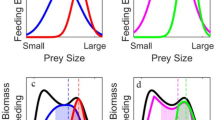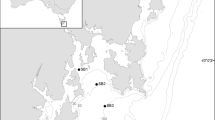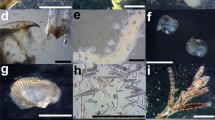Abstract
Salps (mainly Salpa fusiformis and, to a lesser extent, Pegea socia) and a web-building pteropod (Corolla spectabilis) were studied in epipelagic waters of the central California Current. Although both kinds of gelatinous zooplankton trap phytoplankton in a mucus net, a fecal pellet analysis indicated that their diet differs significantly when they feed together, probably because of differences both in the pore sizes of their nets and in their feeding methods. Salps have a finemesh filter, on which they can retain even the smallest phytoplankton; thus, when small coccolithophores are abundant, as they were in our study, salp feces contain such cells and the coccoliths derived from them. In contrast, pteropods feeding in the same area produce fecal pellets consisting chiefly of larger phytoplankton, especially diatoms. Since fecal pellets transport most biogenic material to the deep sea, changes in herbivore species composition at a given geographic location can change the chemistry of materials entering deep water; at our study site, the more salps, the greater the calcite flux, and, the more pteropods, the greater the silica flux. In addition, fecal pellets of both salps and pteropods include partially digested residues of phytoplankton that appear as olive-green spheres, having an ultrastructure identical with that of the socalled olive-green “cells.” Presumably, fecal pellets, after sinking into deep water, ultimately disintegrate. releasing both the viable phytoplankton and the olive-green spheres into aphotic waters. Thus the feces of epipelagic herbivores are likely sources of much of the flora of the deep ocean.
Similar content being viewed by others
Literature Cited
Berner, L. D.: Studies on the Thaliacea of the temperate northeast Pacific Ocean, 144 pp. Ph. D. thesis, Scripps Institution of Oceanography, University of California, San Diego 1957
Berner, L. D.: Distributional atlas of Thaliacea in the California Current region. Calif. coop. ocean. Fish. Invest. Atlas 8, 1–322 (1967)
Bishop, J. K., J. J. Edmond, D. R. Ketten, M. P. Bacon and W. B. Silker: The chemistry, biology, and vertical flux of particulate matter from the upper 400 m of the equatorial Atlantic Ocean. Deep-Sea Res. 24, 511–548 (1977)
Boyd, C. M.: Selection of particle sizes by filter-feeding copepods: a plea for reason. Limnol. Oceanogr. 21, 175–180 (1976)
Brooks, J., P. R. Grant, M. D. Muir, P. van Gijzel and G. Shaw (Eds.): Sporopollenin, 407 pp. London: Academic Press 1971
Bruland, K. W. and M. W. Silver: Sinking rates of fecal pellets from gelatinous zooplankton (salps, pteropods, doliolids). Mar. Biol. (In press). (1981)
Flood, P. R.: Filter characteristics of appendicularin food catching nets. Experientia 34, 173–175 (1978)
Flood, P. R. and A. Fiala-Médioni: Filter characteristics of ascidian food trapping mucous films. Acta Zool., Stockh. 60, 271–272 (1979)
Fournier, R. O.: Studies on pigmented microorganisms from aphotic marine evironments. Limnol. Oceanogr. 15, 675–682 (1970)
Fournier, R. O.: Studies on pigmented microorganisms from aphotic marine environments. II. North Atlantic distribution. Limnol Oceanogr. 16, 952–961 (1971)
Frost, B. W.: Effects of size and concentration of food particles on the feeding behavior of the marine planktonic copepod Calanus pacificus. Limnol. Oceanogr. 17, 805–815 (1972)
Gilmer, R. W.: Free-floating mucus webs: a novel feeding adaptation for the open ocean. Science, N. Y. 176, 1239–1240 (1972)
Gilmer, R. W.: Some aspects of feeding in thecosomatous pteropod molluscs. J. exp. mar. Biol. Ecol. 15, 127–144 (1974)
Harbison, G. R. and R. B. Campenot: Effects of temperature on the swimming of salps (Tunicata, Thaliacea): implications for vertical migration. Limnol. Oceanogr. 24, 1081–1091 (1979)
Harbison, G. R. and R. W. Gilmer: The feeding rates of the pelagic tunicate Pegea confederata and two other salps. Limnol. Oceanogr. 21, 517–520 (1976)
Harbison, G. R. and V. L. McAlister: The fiter-feeding rates and particle retention efficiencies of three species of Cyclosalpa (Tunicata, Thaliacea). Limnol. Oceanogr. 24, 875–892 (1979)
Harbison, G. R. and V. L. McAlister: Fact and artifact in copepod feeding experiments. Limnol. Oceanogr. 25, 971–982 (1980)
Honjo, S. and H. Okada: Community structure of coccolithophores in the photic layer of the mid-Pacific. Micropaleontology 20, 209–230 (1974)
Johnson, P. W. and J. McN. Sieburth: Chroococcoid cyanobacteria in the sea: a ubiquitous and diverse phototrophic biomass. Limnol. Oceanogr. 24, 928–935 (1979)
Jørgensen, C. B.: Biology of suspension feeding, 357 pp Oxford: Pergamon Press 1966
Loeblich, A. R., III and L. C. Morrill: Dinoflagellate cell wall structure and formation. Proc. electron Microsc. Soc. Am. 37, 113–120 (1979)
Loeblich, A. R., III, J. L. Sherley and R. J. Schmidt: The correct position of flagellar insertion in Prorocentrum and description of Prorocentrum rhathymum sp. nov. (Pyrrhophyta). J. Plankton Res. 1, 113–120 (1979)
Madin, L. P.: Field observations on the feeding behavior of salps (Tunicata: Thaliacea). Mar. Biol. 25, 143–147 (1974)
McCave, I. N.: Vertical flux of particles in the ocean. Deep-Sea Res. 22, 491–502 (1975)
McGowan, J.: The Thecosomata and Gymnosomata of California. Veliger 3 (Suppl.), 103–129 (1968)
Mullin, M. M.: Some factors affecting the feeding of marine copepods of the genus Calanus. Limnol. Oceanogr. 8, 239–250 (1963)
Nival, P. and S. Nival: Particle retention efficiencies of an herbivorous copepod, Acartia clausi (adult and copepodite stages): effects on grazing. Limnol. Oceangor. 21, 24–38 (1976)
Okada, H. and A. McIntyre: Modern coccolithophores of the Pacific and North Atlantic Oceans. Micropaleontology 23, 1–55 (1977)
Paffenhöffer, G. A. and S. C. Knowles: Ecological implications of fecal pellet size, production, and consumption by copepods. J. mar. Res. 37, 35–49 (1979)
Porter, K. G.: Enhancement of algal growth and productivity by grazing zooplankton. Science, N. Y. 192, 1332–1334 (1974)
Porter, K. G.: The plant-animal interface in freshwater ecosystems. Am. Scient. 65, 159–170 (1977)
Poulet, S. A. and P. Marsot: Chemosensory feeding and foodgathering by omnivorous marine copepods. In: Evolution and ecology of zooplankton communities, pp 198–218. Ed. by W. C. Kerfoot. Hanover, New Hampshire: University Press of New England 1980
Ringo, D. L., E. H. Cota-Robles and B. J. Humphrey: Low viscosity embedding resins for transmission electron microscopy. Proc. electron Microsc. Soc. Am. 37, 348–349 (1979)
Schiller, J.: Über autochthone pflanzliche Organismen in der Tiefsee. Biol. Zbl 51, 329–334 (1931)
Schroeder, T. E.: Microvilli on sea urchin eggs: a second burst of elongation. Devl Biol. 64, 324–346 (1978)
Silver, M. W.: The habitat of Salpa fusiformis (Chordata: Tunicata) in the California Current as defined by stomach content studies, and the effect of salp swarms on the food supply of the plankton community, 135 pp. Ph. D. thesis, University of California, San Diego 1971
Silver, M. W.: The habitat of Salpa fusiformis in the California Current as defined by indicator assemblages. Limnol. Oceanogr. 20, 230–237 (1975)
Silver, M. W. and A. L. Alldredge: Bathypelagic marine snow: vertical transport system and deep-sea algal and detrital community. J. mar. Res. (In press). (1981)
Strathmann, R. R.: Estimating the organic carbon content of phytoplankton from cell volume or plasma content. Limnol. Oceanogr. 12, 411–418 (1967)
Watson, S. W., T. J. Novitsky, H. L. Quinby and F. W. Valois: Determination of bacterial number and biomass in marine environments. Appl. envirl Microbiol. 33 940–946 (1977)
Author information
Authors and Affiliations
Additional information
Communicated by N. D. Holland, La Jolla
Rights and permissions
About this article
Cite this article
Silver, M.W., Bruland, K.W. Differential feeding and fecal pellet composition of salps and pteropods, and the possible origin of the deep-water flora and olive-green “Cells”. Mar. Biol. 62, 263–273 (1981). https://doi.org/10.1007/BF00397693
Accepted:
Issue Date:
DOI: https://doi.org/10.1007/BF00397693




